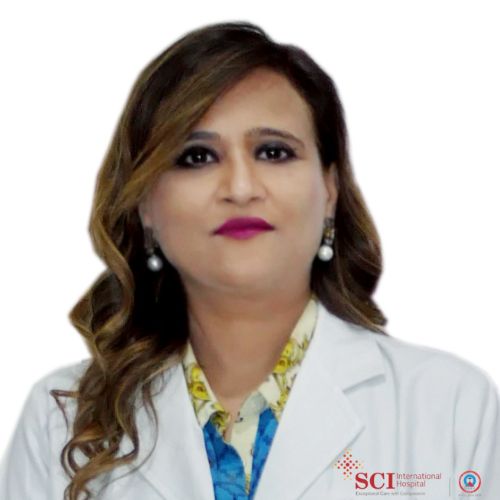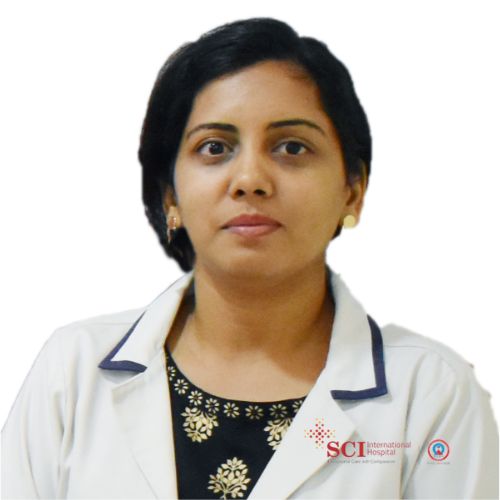The embryo transfer is a pivotal and hopeful moment in your In Vitro Fertilization (IVF) journey. At SCI Hospital in Delhi, our dedicated team ensures this delicate procedure is performed with the utmost precision and care, bringing you one step closer to achieving your dream of pregnancy. This guide will walk you through what to expect during your embryo transfer at SCI Hospital.
We Are Rated
Consult Now
The embryo transfer is the final and perhaps most anticipated step in the IVF process. It's the moment where all the preceding efforts culminate in the placement of a carefully nurtured embryo into the uterus.
Embryo transfer is a simple procedure that involves placing one or more embryos, which have been developing in the IVF laboratory, into a woman's uterus. This occurs after the eggs have been retrieved and fertilized with sperm, and the resulting embryos have been cultured for several days.
The primary goal of embryo transfer is for the embryo(s) to implant into the uterine lining (endometrium). Successful implantation leads to a pregnancy, which can then be confirmed with a pregnancy test a couple of weeks later.
Knowing what happens during the embryo transfer can help ease any anxiety. At SCI Hospital, Delhi, we ensure you are informed and comfortable throughout the process.
Preparation for Embryo Transfer: What Patients Need to Know
Proper preparation is key to optimizing the chances of a successful embryo transfer.
Uterine Lining Preparation and Monitoring
Before the transfer, your uterine lining (endometrium) must be adequately prepared to receive the embryo. This often involves taking medications like estrogen and progesterone to thicken the lining. Our specialists at SCI Hospital will closely monitor your endometrial thickness and quality through ultrasound scans.
Instructions Before the Procedure (e.g., full bladder)
You will receive specific instructions from our team at SCI Hospital before your embryo transfer. Commonly, patients are asked to arrive with a comfortably full bladder, as this helps to straighten the angle of the uterus and allows for better visualization during the ultrasound-guided transfer.
How is Embryo Transfer Performed? The In-Clinic Process
The embryo transfer itself is a relatively quick and minimally invasive procedure performed in our dedicated suite at SCI Hospital.
The Catheter Method: A Gentle Approach
The embryos are loaded into a thin, flexible tube called a catheter. The fertility specialist gently passes this catheter through the cervix and into the uterus, carefully depositing the embryos.
Ultrasound Guidance for Precision
To ensure precise placement of the embryos, the transfer is typically performed under ultrasound guidance. This allows the specialist to visualize the catheter and the optimal location within the uterine cavity for placing the embryos.
Is the Embryo Transfer Procedure Painful?
Most women find the embryo transfer procedure to be painless, similar to undergoing a Pap smear. Some may experience mild discomfort or cramping, but anesthesia is generally not required. Our team at SCI Hospital prioritizes your comfort.
What Happens Immediately After the Transfer?
After the embryos are transferred, the catheter is carefully removed. You will be advised to rest for a short period at the clinic (usually 15-30 minutes) before you can go home.
There are different approaches to embryo transfer, and the best option for you will be determined by our fertility specialists at SCI Hospital based on your individual circumstances.
Fresh vs. Frozen Embryo Transfer (FET): Pros and Cons
Pros:
Cons:
An FET may be recommended by specialists at SCI Hospital if there is a risk of OHSS, if the uterine lining is not optimal during the fresh cycle, if Preimplantation Genetic Testing (PGT) is planned, or for fertility preservation purposes.
Embryos can be transferred at different stages of development.
Transferring embryos at the blastocyst stage allows embryologists to select the most viable embryos that have demonstrated continued development. This often leads to higher implantation rates per transfer and allows for the transfer of fewer embryos, reducing the risk of high-order multiple pregnancies. SCI Hospital often prefers blastocyst transfers when feasible.
The decision on whether to perform a Day 3 or Day 5/6 transfer is made by our fertility specialists and embryologists at SCI Hospital, considering factors like the number and quality of embryos, your previous IVF history, and your specific medical situation.
Several factors can influence the likelihood of a successful embryo transfer and subsequent pregnancy.
Quality of the Embryo(s)
The quality of the embryo is one of the most critical factors. High-quality embryos, as assessed by our embryologists at SCI Hospital, have a better chance of implanting and developing into a healthy pregnancy.
Uterine Receptivity and Health of the Endometrial Lining
A healthy, receptive uterine lining (endometrium) of adequate thickness and quality is essential for the embryo to implant.
The Skill and Experience of the Fertility Specialist & Embryologist
The expertise of the fertility specialist performing the transfer and the embryologist handling the embryos plays a significant role. The gentle and precise placement of the embryo is crucial. SCI Hospital prides itself on its experienced team.
Age of the Woman
A woman's age is a significant factor, as egg quality tends to decline with age, which can affect embryo quality and implantation rates.
Lifestyle Factors (Smoking, Weight, Stress)
Lifestyle factors such as smoking, being significantly overweight or underweight, and high levels of stress can negatively impact IVF success rates, including implantation.
Adherence to Post-Transfer Instructions
Following the post-transfer instructions provided by our team at SCI Hospital, including taking prescribed medications, is important for supporting a potential pregnancy.
What to Expect After Your Embryo Transfer: The "Two-Week Wait"
The period after the embryo transfer, often called the "two-week wait" (TWW), is the time until your pregnancy test. This can be an emotionally charged time filled with anticipation.
Post-Transfer Care and Recommendations
Our team at SCI Hospital will provide you with specific instructions for post-embryo transfer care. While some rest is advised on the day of transfer, most women can resume normal, light activities the following day. Strenuous exercise or heavy lifting should generally be avoided. We will provide personalized advice. You will likely be prescribed progesterone and possibly other medications to support the uterine lining and a potential early pregnancy. It's crucial to take these medications as directed by your SCI Hospital specialist. Activity Levels: Rest vs. Normal Routine
Medications (e.g., Progesterone Support)
Early Pregnancy Symptoms vs. Medication Side Effects
During the TWW, you might experience symptoms like mild cramping, bloating, fatigue, or breast tenderness. It's important to note that these can be due to early pregnancy or the side effects of progesterone medication. Try not to read too much into symptoms during this time.
The Pregnancy Test: When and How It's Done
A blood test (beta-hCG) is typically scheduled at SCI Hospital about 10-14 days after the embryo transfer to determine if pregnancy has occurred. This test is more accurate than home urine pregnancy tests in early pregnancy.
At SCI Hospital, we are committed to providing the highest standard of care for your embryo transfer procedure.
Our Expert Team of Fertility Specialists and Embryologists
SCI Hospital boasts a highly skilled team of fertility specialists and embryologists in Delhi with extensive experience in performing successful embryo transfers.
Advanced Laboratory Techniques for Embryo Culture and Selection
Our state-of-the-art IVF laboratory at SCI Hospital utilizes advanced techniques for optimal embryo culture and selection, maximizing the chances of transferring a healthy embryo.
Personalized Embryo Transfer Protocols
We understand that each patient is unique. At SCI Hospital, we tailor embryo transfer protocols to your individual needs and circumstances for the best possible outcome.
Patient Comfort and Support During the Procedure
Your comfort and well-being are paramount. Our compassionate team at SCI Hospital provides a supportive environment throughout the embryo transfer process, addressing any concerns you may have.
While embryo transfer is generally a safe procedure, there are some potential risks and considerations.
Multiple Pregnancies (Twins, Triplets)
If more than one embryo is transferred, there is an increased risk of multiple pregnancies (twins, triplets). While this may seem desirable to some, multiple pregnancies carry higher risks for both the mother and babies. Our specialists at SCI Hospital will discuss the optimal number of embryos to transfer.
Ectopic Pregnancy (Rare)
In rare cases (about 1-2% of IVF pregnancies), the embryo may implant outside the uterus, most commonly in a fallopian tube. This is called an ectopic pregnancy and requires medical attention.
Mild Cramping or Spotting
It is common to experience some mild cramping or light spotting for a day or two after the embryo transfer. This is usually not a cause for concern, but you should report any heavy bleeding or severe pain to our team at SCI Hospital.

MBBS, MD - Obstetrics & Gynaecology, DNB - Obstetrics & Gynecology, Infertility Specialist

DNB - Obstetrics & Gynecology, DGO, MBBS, Gynecologist, Obstetrician
The number of embryos transferred depends on various factors, including the woman's age, embryo quality, previous IVF attempts, and the clinic's policy. At SCI Hospital, we generally recommend transferring one or two embryos (Single Embryo Transfer or Double Embryo Transfer) to maximize the chance of a healthy singleton pregnancy and minimize the risk of multiples. The decision is always made in consultation with you.
Embryo transfer success rates vary widely depending on factors like maternal age, cause of infertility, embryo quality, and the clinic's expertise. Blastocyst transfers generally have higher success rates per transfer. (SCI Hospital can insert a link to their specific success rates page here or provide a general range based on their outcomes if their policy allows).
While there's no magic formula, following your doctor's instructions at SCI Hospital is key. This includes taking prescribed medications, maintaining a healthy lifestyle (avoiding smoking, alcohol, and excessive caffeine), managing stress, and eating a balanced diet. Avoid strenuous activities as advised.
It's generally advisable to avoid long or strenuous travel for a few days after the embryo transfer to allow for rest. Short-distance travel, like going home from the clinic, is usually fine. Discuss any specific travel plans with your specialist at SCI Hospital for personalized advice.
If an embryo transfer does not result in pregnancy, it can be deeply disappointing. Our compassionate team at SCI Hospital will provide support and schedule a follow-up consultation to discuss the cycle, potential reasons for the outcome, and explore next steps. This may involve reviewing the cycle details, considering further investigations, or discussing adjustments for future attempts.
Consult Now
